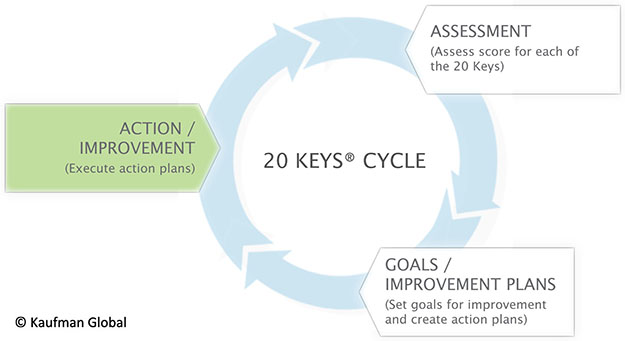Continuous Improvement And The 20 Keys®
On the Continuous Improvement Journey, It Pays to Look in the Rear view Mirror
Business leaders are often criticized for their tendency to keep looking “in the rear view mirror,” but is this always a bad thing? In life there are frequent occasions when one can learn from events of the past to augment future outcomes. Where Continuous Improvement (CI) activities are concerned, monitoring and tracking quantifiable results over time maintains focus on increasing levels of performance.
Knowledge and expertise stem from both good and bad past experiences. As much as we admire the entrepreneurial spirit of those who seem to be charging ahead at the speed of light, the truth is that successful innovators occupy a significant amount of their time studying the “lessons learned” of their predecessors. Unfortunately, it’s far too common for organizations to follow a well-trodden path and then stop abruptly when other priorities arise. Experiences are often lost, and errors are later repeated. In the end, past efforts are often wasted as the creative ideas from former teams are constantly reinvented.
When it comes to continuous improvement, it’s imperative that time be dedicated to holding standard, prescriptive, and quantitative reviews that evaluate the effectiveness of CI efforts. A concentrated effort should be made to discuss and formally document successes and failures of any significant flow of tasks and activities. If one thinks about it, every workflow should be a continuous loop of tasks from which the concept of CI can grow and flourish. This is equally applicable to such innovative functions as new product development or to the more mundane activities associated with financial month-end closing. CI effectiveness reviews are a critical success factor for any initiative in order to continually build on prior efforts.
To quantify, monitor and review continuous improvement progress, there is no better tool than Kaufman Global’s 20 Keys ®, a proprietary method for focusing an intact workgroup on the 20 most important elements of how it is operating versus world-class (or better) standards. The 20 Keys automates the review process by regularly assessing current state, targeting future performance levels and implementing a month-to-month plan for improvement.
 As identified in the 20 Keys Cycle illustration above, the method drives a continuous cycle of improvement and builds on prior efforts. Typically repeated four times per year, location leadership or a designated representative works with the workgroup to assess their score for each of the 20 keys. This is an honest, direct exchange in which the they score each key against known criteria. Once the assessment is done, this same workgroup decides on which key(s) they should focus on improving. The objective is for them to increase their overall score by 10 points per year.
As identified in the 20 Keys Cycle illustration above, the method drives a continuous cycle of improvement and builds on prior efforts. Typically repeated four times per year, location leadership or a designated representative works with the workgroup to assess their score for each of the 20 keys. This is an honest, direct exchange in which the they score each key against known criteria. Once the assessment is done, this same workgroup decides on which key(s) they should focus on improving. The objective is for them to increase their overall score by 10 points per year.
A universal process, organizations throughout the world have implemented 20 Keys successfully. To date, Kaufman Global has developed more than 25 different sets of keys that are applicable to both industry and functional applications, including Customer Service, Logistics and Supply Chain Management, Engineering, and Project Management, among others. Regardless of which key sets are used, the 20 Keys process provides a standardized approach for measuring CI effectiveness across functions and locations.
It’s time to make a fully documented review procedure (that includes targeted metrics) part of your organization’s way of life — no matter what industry or business function you happen to be working in. Think about it. What did you learn from your recent improvement efforts, what was measured to evaluate results, and how can those results be improved?
To learn more about Kaufman Global’s 20 Keys download our White Paper: Continuous Improvement and The 20 Keys ®







